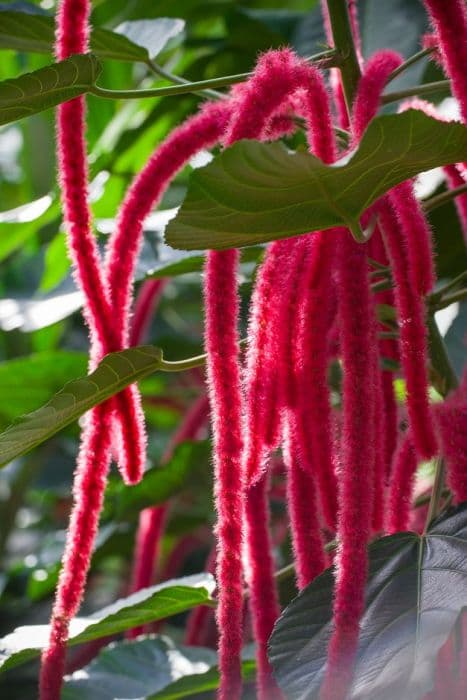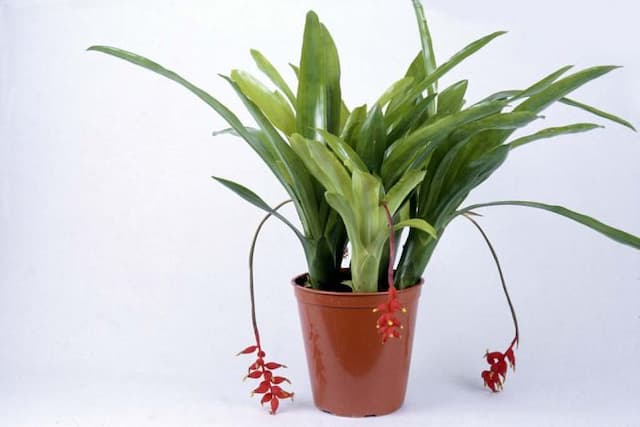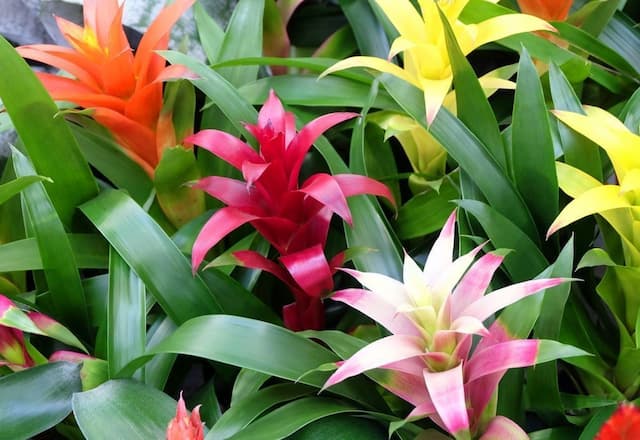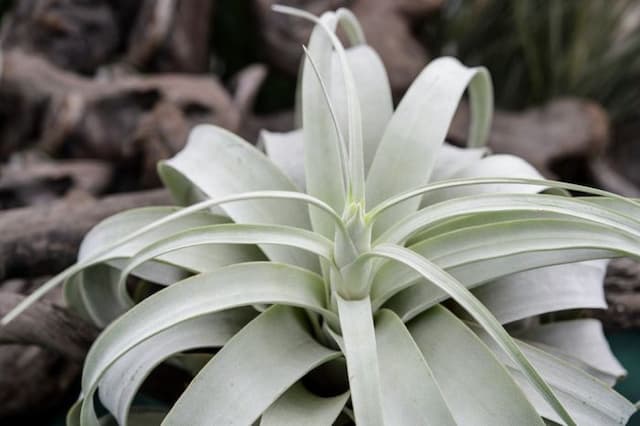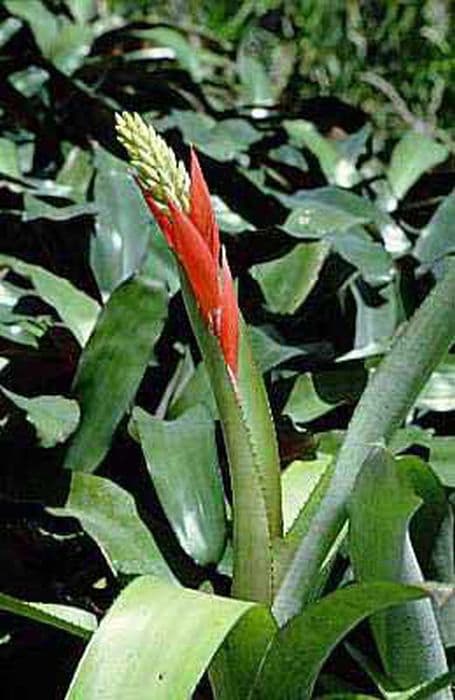Bulbous air plant Tillandsia bulbosa

ABOUT
Tillandsia bulbosa, commonly known as the bulbous air plant, has a striking and unusual appearance that sets it apart from other plants. The most notable feature is its bulbous base, which gives the plant its common name. From this swollen base, long, slender leaves emerge and curl in various directions, resembling squiggly, tentacle-like arms. These leaves are smooth and have a unique, shiny appearance that can range in color from bright green to a deep, purplish-green, depending on the amount of light the plant receives. The leaves of the bulbous air plant often appear to be covered with a silvery-gray, dust-like coating. This is due to tiny structures on their surface that help the plant absorb moisture and nutrients from the air. The leaves are also capable of changing their orientation and can open or close in response to humidity levels. During the blooming period, the bulbous air plant produces a tall spike that emerges from the center of the bulbous base. The color of the spike and its flowers can vary, typically displaying vibrant hues like bright purple or red, which contrast dramatically against the green of the leaves. The blooms are striking and add an exotic flair to the plant's overall look. Overall, Tillandsia bulbosa is a distinctive and visually captivating plant that can add a touch of the unusual to any indoor plant collection or serve as a curious addition to an air plant terrarium. Its otherworldly form and the ability to grow without soil make it both an intriguing and low-maintenance choice for plant enthusiasts.
About this plant
 Names
NamesSynonyms
Bulbous Air Plant, Sea Onion.
Common names
Tillandsia bulbosa var. bulbosa, Tillandsia bulbosa var. praetexta, Tillandsia pulchella, Vriesea bulbosa, Platystachys bulbosa, Tillandsia pumila, Anoplophytum bulbosum, Tillandsia graveolens, Tillandsia laxa, Tillandsia miniata, Tillandsia pruinosa, Tillandsia retorta, Diaphoranthema bulbosa, Pityrophyllum bulbosum, Viridantha bulbosa.
 Toxicity
ToxicityTo humans
Tillandsia bulbosa, commonly known as Bulbous air plant, is generally considered non-toxic to humans. There are no widespread reports of poisoning from ingestion of this plant. As with many non-edible plants, consuming large quantities may cause gastrointestinal discomfort or irritation, but it is not regarded as poisonous.
To pets
Bulbous air plant is not toxic to pets such as cats and dogs. There should be no significant risk of poisoning if pets come into contact with or ingest parts of Tillandsia bulbosa. However, it is still advisable to prevent pets from eating ornamental plants, as they can sometimes cause mild digestive upset.
 Characteristics
CharacteristicsLife cycle
Perennials
Foliage type
Evergreen
Color of leaves
Green
Flower color
Purple
Height
6 inches (15 cm)
Spread
6 inches (15 cm)
Plant type
Herb
Hardiness zones
10
Native area
Central America South America
Benefits
 General Benefits
General Benefits- Low Maintenance: Tillandsia bulbosa requires minimal care, making it an ideal plant for those with busy lifestyles or beginners in gardening.
- Improves Humidity: By releasing moisture into the air through the process of transpiration, it can help maintain indoor humidity levels.
- Unique Aesthetic: With its unusual bulbous base and tentacle-like leaves, Tillandsia bulbosa provides a striking and unique addition to home or office decor.
- No Soil Needed: It grows without soil, absorbing water and nutrients through its leaves, which makes it versatile in terms of placement and reduces potential mess.
- Pet-Friendly: This plant is non-toxic to cats and dogs, making it safe to keep in homes with pets.
 Medical Properties
Medical PropertiesThis plant is not used for medical purposes.
 Air-purifying Qualities
Air-purifying QualitiesThis plant is not specifically known for air purifying qualities.
 Other Uses
Other Uses- Tillandsia bulbosa can be used as a living art piece, where the plant is incorporated into frames or sculptures due to its unique bulbous shape and tentacle-like leaves.
- This plant serves as a unique habitat for small invertebrates when grown in terrariums, providing shelter and micro-climatic conditions.
- It can be utilized in jewelry making, where dried Tillandsia bulbosa are fashioned into pendants or earrings for a natural and eco-friendly accessory.
- As a natural decor, Tillandsia bulbosa can be attached to driftwood or shells to create a nautical-themed aesthetic in homes or offices.
- These plants can be used in educational settings, such as classrooms or workshops, to teach about epiphytism and plant adaptation strategies.
- Tillandsia bulbosa can be incorporated into Christmas ornaments or holiday wreaths for a unique, tropical twist on traditional festive decorations.
- In crafting, they can be used for fairy garden creations, providing an otherworldly look due to their unusual growth form.
- This species can be used in hanging mobiles for nurseries, providing a calming, natural visual stimulus for infants.
- For themed events like Halloween, Tillandsia bulbosa can be used to create eerie and spooky decorative elements that resemble sea creatures or aliens.
- In cinematography and theater, they can be utilized as props to represent alien flora or exotic plants in sci-fi and fantasy settings.
Interesting Facts
 Feng Shui
Feng ShuiThe Tillandsia is not used in Feng Shui practice.
 Zodiac Sign Compitability
Zodiac Sign CompitabilityThe Tillandsia is not used in astrology practice.
 Plant Symbolism
Plant Symbolism- Resilience: Tillandsia bulbosa, like many air plants, doesn’t require soil to grow, signifying the ability to thrive in challenging conditions.
- Independence: Its soil-less nature also symbolizes independence and the capability to sustain oneself without relying heavily on external support.
- Adaptability: This plant adapts to various environmental conditions, reflecting the importance of being versatile and flexible in life's situations.
- Uniqueness: With its bulbous shape and tentacle-like leaves, Tillandsia bulbosa stands out from other air plants, symbolizing uniqueness and individuality.
- Protection: The bulbous base of the plant serves as a water reservoir, symbolizing self-preservation and protection from life's uncertainties.
- Air Purity: As an air plant, it symbolizes cleansing and improving the environment around it, which can be seen as a metaphor for removing negativity from one's surroundings.
 Water
WaterBulbosa air plants should be watered by soaking them in a bowl of water for 15 to 30 minutes every one to two weeks. After soaking, shake off any excess water and let them dry upside down to prevent water from collecting at the base, which can cause rot. In drier or hotter environments, they may require more frequent waterings, possibly up to once a week, while in more humid climates, less frequent waterings may suffice. Always ensure that the water is at room temperature. For larger or more mature plants, an occasional deep soak every few weeks might be beneficial.
 Light
LightThe Bulbosa air plant thrives in bright, indirect sunlight. A north-facing window or a spot that receives filtered sunlight is ideal to prevent the leaves from getting sunburned. Direct sunlight should be avoided especially during the peak hours of the day as it can cause the plant to dry out too quickly and become damaged.
 Temperature
TemperatureThe ideal temperature conditions for the Bulbosa air plant range from 50 to 90 degrees Fahrenheit. They can survive a minimum temperature of around 45 degrees Fahrenheit but should not be exposed to cold drafts or temperatures below this as it can lead to damage. Maximum temperature should not exceed 90 degrees Fahrenheit to avoid heat stress. Maintaining a consistent temperature within these ranges will help the plant thrive.
 Pruning
PruningPruning is not frequently required for the Bulbosa air plant but doing so can help remove any dead or brown leaves to encourage healthier growth. Prune sparingly, using sharp scissors, and only remove the damaged or dead leaves. The best time for pruning is during the plant's growing season, typically spring or early summer, which can also aid in healthier regrowth.
 Cleaning
CleaningAs needed
 Soil
SoilThe best soil for Bulbosa air plant isn't soil at all as it's an epiphyte, thriving on mounting surfaces or in bark pieces without soil; it prefers a pH around 5.5 to 6.0.
 Repotting
RepottingBulbosa air plants do not require repotting as they absorb nutrients and water through their leaves and are often displayed without traditional soil.
 Humidity & Misting
Humidity & MistingIdeal humidity conditions for Bulbosa air plant are between 50%-70%, which mimic their native tropical rainforest habitat.
 Suitable locations
Suitable locationsIndoor
Mount Bulbosa air plant on bark or place in a terrarium with bright, indirect light.
Outdoor
Hang Bulbosa air plant in a shaded spot with good air circulation, protect from extreme temperatures.
Hardiness zone
9-11 USDA
 Life cycle
Life cycleTillandsia bulbosa, commonly known as Bulbous air plant, begins its life cycle as a seed, which upon germination, develops into a small plantlet. The plant gradually matures, producing long, twisting leaves that form a bulb-like structure at the base. This slow-growing epiphyte absorbs moisture and nutrients through its leaves from the air and rainwater. When it reaches maturity, it produces a spike with bright, tubular flowers, which after pollination, can lead to the production of seeds. These seeds are then dispersed by the wind to new locations where they can germinate. After flowering, the parent plant gradually dies, but it may produce offsets, or "pups," at its base, which continue the growth cycle.
 Propogation
PropogationPropogation time
Spring-Summer
Propogation: The most popular method of propagating a Tillandsia bulbosa, commonly known as the Bulbous air plant, is through the division of offset or "pup" that it produces after flowering. Propagation is best done during its active growth period, which can vary but is often in the spring or early summer. Once a pup has reached about one-third the size of the parent plant, it can be gently pulled apart from the base of the mother plant. It is important to ensure that the offset has developed its own roots before separating it to ensure its best chance of survival. After removal, the pup can be placed in a new location where it can receive adequate light and air circulation to thrive. Care should be taken not to damage the pup or the mother plant during the separation process.
